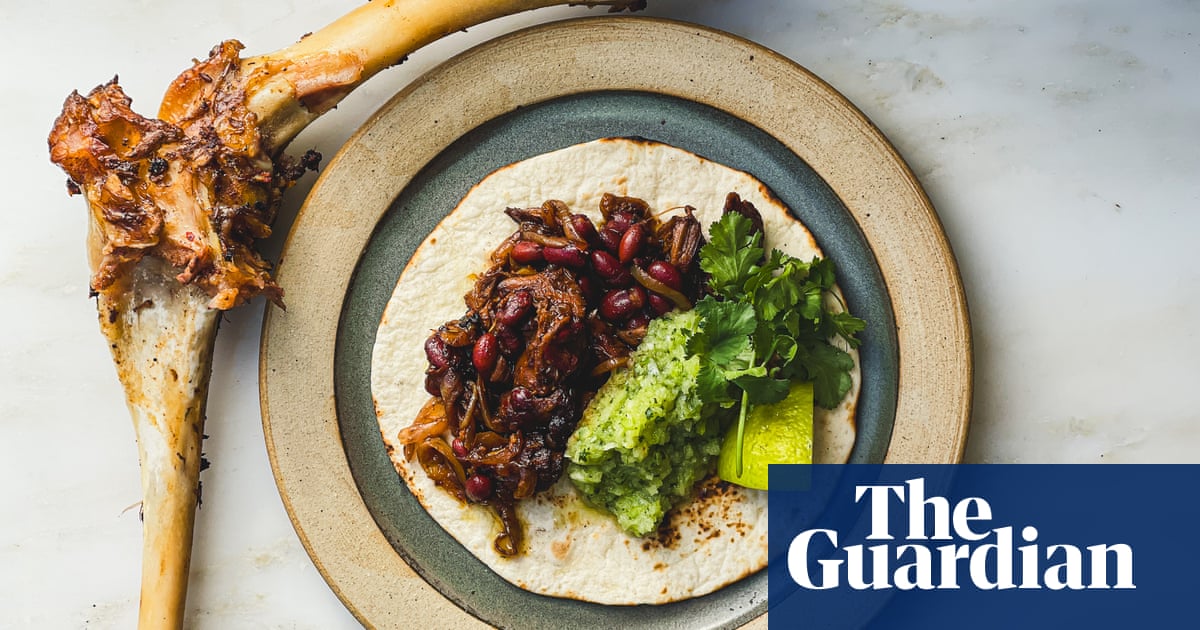If you’re anything like me, you love a big roast dinner on Sundays. A joint of meat is a magnificent offering, but it can sometimes be hard to carve cleanly, and you end up leaving chunks of meat and flavoursome fat on the bone. These scraps are perfect for turning into succulent, tasty tacos. Cut any meat and fat off the bone, then shred with two forks. I’ve added black beans to bulk out the meat; if you have less meat, or want to make a vegetarian version, just use an extra tin of beans.
Barbacoa de Borregois a traditional Mexican dish of tender slow-cooked lamb (or mutton) that’s often wrapped in agave or banana leaves and baked in an underground pit. Rich, smoky and deeply spiced, it’s typically served shredded in tacos with salsas, lime and fresh herbs. This speedy but satisfying shortcut version captures the essence of the dish using leftover roast lamb and pantry spices.
Roast meat is an incredible resource – it takes so much energy to produce, from the land, water and fuel used to farm, transport and store the meat, to the time and energy we put into cooking it – so any extras we make from it are delicious meals in waiting. The meat can simply be reheated until piping hot for a quick, comforting “ready-meal”, or you can turn them into something more elaborate such as today’s dish.
Mexican chillies are well worth seeking out for this dish, and larger supermarkets are starting to stock them more regularly; alternatively, look in specialist shops and online. I used a ready mix of guajillo, ancho and chipotle flakes, which are all classic chillies commonly used in traditional barbacoa. Chipotle and other Mexican chillies add an extra layer of smokiness and depth to the dish, but a mix of chilli flakes and smoked paprika will also work, if need be. And if you don’t have a mortar and pestle, it’s fine to leave the chilli flakes and cumin whole – just be sure to mince the garlic finely before mixing it with the rest of the ingredients.
The green apple salsa verde, meanwhile, is inspired by Mexican tomatillo sauces, and adds a refreshing, tangy kick that cuts through the richness of the meat and balances the dish beautifully.
Makes6 tacos
3 tsp chilli flakes or powder, Mexican, ideally (guajillo, ancho and/or chipotle), or regular chilli flakes and smoked paprika1 tsp cumin seeds(optional)3 garlic cloves, peeled and roughly chopped1 tbsp lime juice, or cider vinegar2 tbsp vegetable oil1 tbsp brown sugar1 tsp sea salt, plus extra for the salsa1 tsp ground cinnamon1 tsp oregano200–250g leftover cooked roast lamb, shredded1 medium white onion, peeled and thinly sliced400g tin kidney, blackor black eyebeans, plus a little of the liquid from the can (if making vegetarian tacos, use 2 tins of beans)6 small tortillasLime wedges, to serve (optional)Fresh coriander, to serve (optional)
For the green apple Mexican-style salsa verde (optional)1 green apple(such as a granny smith), cored and roughly chopped, core removed1 fresh green chilli(jalapeño or serrano, ideally), finely chopped, with or without seeds, depending on your liking for heat½ small white onion, roughly chopped1 garlic clove, peeled20g fresh coriander, chopped from stem to leafJuice of 1 lime, plus the finely grated zest, if unwaxed and organic
Toast the chilli flakes or powder and cumin seeds in a dry pan for a couple of minutes, until they smell spicily aromatic. Transfer to a mortar, grind to a coarse powder, then add the chopped garlic and crush to a paste. Mix in the brown sugar, lime or vinegar, a tablespoon of oil, the sea salt, cinnamon and oregano.
Put a tablespoon of the oil in a thick-based frying pan on a medium heat, add the sliced onion, lamb and the spice paste, stir to combine, then saute gently, stirring occasionally, for about 15 minutes, until the lamb and onions are caramelised. Add the beans and enough of their tin liquid to make the mix saucy, then simmer, stirring often, until thick and sticky.
Meanwhile, make the salsa verde. Put everything in a blender, then pulse until everything is evenly and finely chopped; if need be, add a splash of water to loosen and help things along. Season to taste with sea salt, and transfer to a bowl.
Serve the lamb mix in warm griddled tortillas with lime wedges, coriander and an optional spoonful of my salsa verde to taste. Any excess salsa will keep in a sealed container or jar in the fridge for up to four days.
